Colli Orientali del Friuli celebrates a blending of a Mediterranean with an Alpine climate–the mild temperatures brought by the sea, coupled with the drying winds from air rushing water to mountain. The calcium rich ponca (marl) of the Eonician sea bed that covers the appellation guarantees distinct minerality in the wines as well. As a result, the area is brilliant for white wines, and creates world class examples from a range of grapes.
Indigenous Grapes
As mentioned here previously, the wine makers of Colli Orientali carry a deep commitment to grapes indigenous to their hills and valleys. As a result, the region hosts wines truly unique to their soils.
Friulano
click on comic to enlarge
Considered the signature white of Friuli-Venezia Giulia, Friulano boasts a combination of rich texture, full body, and delicate flavors. Tending towards moderate to lower acid, wines from this grape readily carry a rounded, almost fatty mouth feel. However, many wine makers of Colli Orientali play with such texture by beginning to test for acid levels on the grapes early, striving for that perfect balance of rich texture and still bright acidity.
Malvasia Istriana
click on comic to enlarge
One of several grapes known as part of the Malvasia family, Malvasia Istriana is a strain native to the Istria peninsula, and readily grown in Colli Orientali, as well as Collio of Friuli-Venezia Giulia. This strain of Malvasia grows throughout the border region of Friuli, found in the hillsides of its nearest neighbors as well–Croatia and Slovenia.
Claiming the grape is indigenous to Friuli is lightly slippery as the grape is believed to originate from cuttings brought by merchants from Greece and then planted in the Friulian hillsides. Today, the grape grows almost exclusively in the Friuli region. However, some small plantings are also to be found in Emilia, to the southwest of Friuli, where it is used to produce a sparkling white wine.
Picolit
click on comic to enlarge
An unusual grape that celebrates a firm foothold throughout Colli Orientali, Picolit is used primarily in the region for making a sweet, dessert style wine. However, some wine makers also use small quantities of the grape in white blends to bring a fuller body and lightly sweet notes to their wine.
Picolit has been found to be an incredibly old variety with information showing it reaching back all the way to the Roman empire. In its history, Picolit has celebrated distinction at the tables of emperors and popes, as well as leaders from countries throughout Europe. It has also nearly faced extinction only to be saved again through its offering as a gift to kings through Europe.
Today many wine growers in Colli Orientali have at least some small portion of Picolit planted. It is considered a wine to share with friends, or give as a gift, and is often celebrated at the end of a meal as a token of “sweets for the last.”
Picolit also boasts its own DOCG as it is considered a unique grape and associated style with excellent quality.
Ribolla Gialla
click on comic to enlarge
Because of its documented history back to the 14th century, Ribolla Gialla is believed to be even older to the region. The grape showcases a brilliantly clean neutrality that allows it to really show the unique minerality of the region’s soils. The varieties naturally high acidity keeps its wines crisp and light serving as a wonderful palate cleanser. Historically, the wine was also used to make sweet wines, but today is generally produced clean and dry.
Verduzzo friulano
click on comic to enlarge
Grown throughout Friuli, Verduzzo friulano is commonly associated with the DOCG designated wine Ramandolo, of the hills of the village Ramandolo. There the grape is treated to a unique sweet wine process that keeps good acidity alongside mouth gripping tannins.
The wine Ramandolo has a documented history back to the 15th century where it is known to have been served to popes and distinguished nobles. However, the grape’s history in the region of Friuli is believed to reach back to ancient times.
The grape Verduzzo friulano is unique in that it is a white variety that carries very high tannin levels. Its nearest genetic relatives have been shown to be entirely made up of red grapes, and so it is believed that Verduzzo originates as a genetic mutation from a red grape.
Though the grape is most commonly used to make the sweet wine Ramandolo, it is also used by some wine makers as a blending grape bringing textural qualities and weight to their white wines.
International Varieties
Though Colli Orientali has a special focus on its indigenous grapes the region also celebrates a host of high quality white wines from International varieties.
Chardonnay
click on comic to enlarge
Colli Orientali showcases a host of wonderfully crisp, good aging, good quality Chardonnays with many wine makers choosing to produce varietals of this grape without oak influence. Other wine makers in the area choose to generate a richer bodied, still mineral driven rendition by allowing malo-lactic fermentation and oak influence.
Chardonnay is considered one of the most important international white varieties in the region, though originally it was planted under the belief that the clones were Pinot Bianco. Today the confusion has been cleared up and the region readily grows quality chardonnay vines.
Pinot Bianco
click on comic to enlarge
A uniquely flavored and scented variety, Pinot Bianco (aka. Pinot Blanc) originates in France as a mutation of Pinot Nero (aka Pinot Noir). Though the grape is now less commonly grown in Colli Orientali than the international varieties Chardonnay or Sauvignon, there are some distinct, good quality Pinot Biancos celebrated in the region. Its good acidity and warming alcohol levels make it a nice pairing for richer starter dishes like lightly creamy soups, or egg dishes.
Pinot Grigio
click on comic to enlarge
Though the grape Pinot Grigio is commonly associated with a crisp, clean, light flavored style wine, the variety originally tended to have a much fuller body and richer flavor in the Colli Orientali region.
Prior to the 1960s, the more common production style for this wine was to ferment it on skins allowing the pink or gray color of the grape to tint the juice, and the tannin and flavor of the grape body to impact the wine as well. The practice known as Pinot Grigio Ramato is still made in the region ranging from only a couple of days on skins with filtering following–leading to a richly textured, more fully flavored but still light bodied wine–to a full month on skins–creating a brightly colored, highly textured ‘white’ wine. Though they can be found, these extended skin-contact wines are not commonly sold on the market.
It is usual, however, to find the more commonly expected ultra light, often steely, apertif style wine from Pinot Grigio. Today Pinot Grigio from Colli Orientali will be sold either as a white, or as a lightly copper colored wine from skin contact occurring for 48 hours or less.
Riesling
click on comic to enlarge
One of the less cultivated international varieties in the region, Riesling was imported to the region from Germany and is used in Colli Orientali to produce a dry style, crisp white wine with good acidity and bright, fresh fragrance.
Some of the wine makers we met referred to it as their project for fun.
Sauvignon
click on comic to enlarge
Named by Bobby Stuckey, of Frasca in Boulder, as Colli Orientali’s “secret weapon,” Sauvignon (Blanc) has garnered special attention in and for the appellation. The consortium of wine makers for Colli Orientali del Friuli invested in a six-year research project specifically focused on the grape as a means of both determining what made the variety distinctive in its region, and to compare it against the famous Sauvigon Blancs of both France and New Zealand. The result of the study was to move forward an already world class quality wine.
The minerality of the soil produces a crisp herbal and tomato leaf nose to the wine coupled with good structure and a full body. The bright acidity makes it well suited to food, or as a pleasing apertif.
Traminer aromatico
click on comic to enlarge
Known elsewhere as Gewurtztraminer, Traminer aromatico carries an unknown origin with some placing its start in Germany, and others in the Alsace region of France. Its movement into Italy is also uncertain, but today it is most commonly grown in Trentino, and in Friuli. That said, it is a beloved grape to the region, and yet also less focused on than the international whites of Chardonnay and Sauvignon.
The grape is known for its highly aromatic qualities, and in Colli Orientali its overall crispness is boosted by the growing conditions of the region.
***
Copyright 2012 all rights reserved. When sharing or forwarding, please attribute to WakawakaWineReviews.com
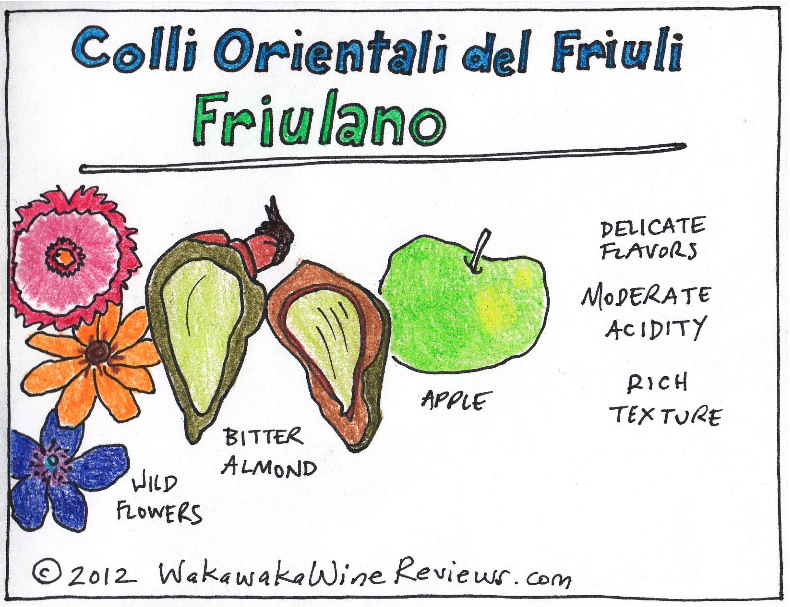


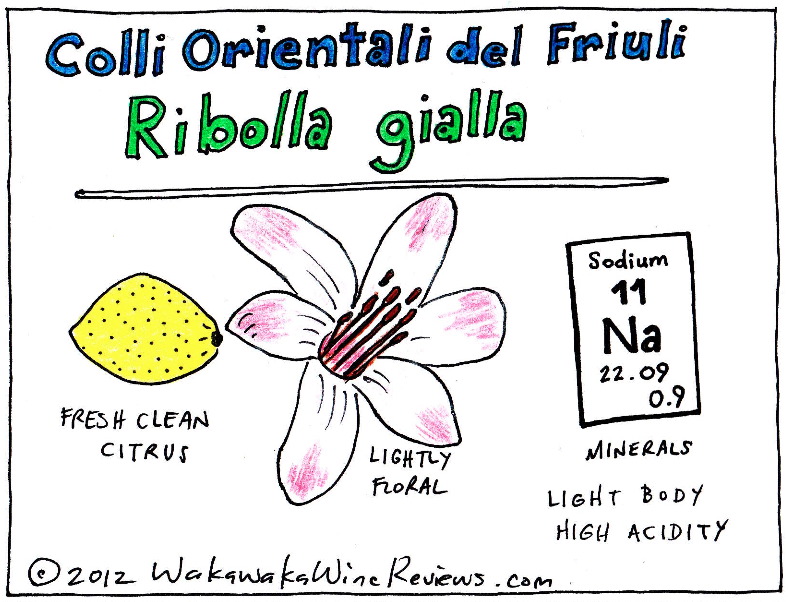


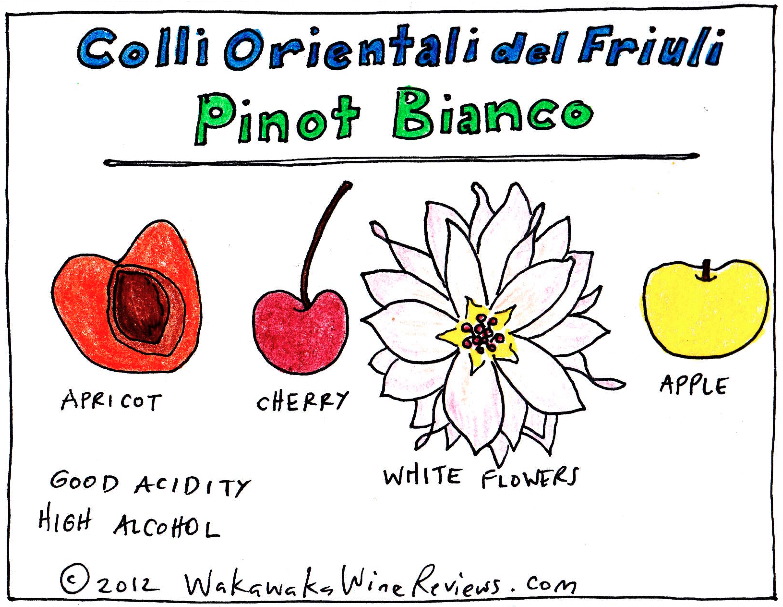
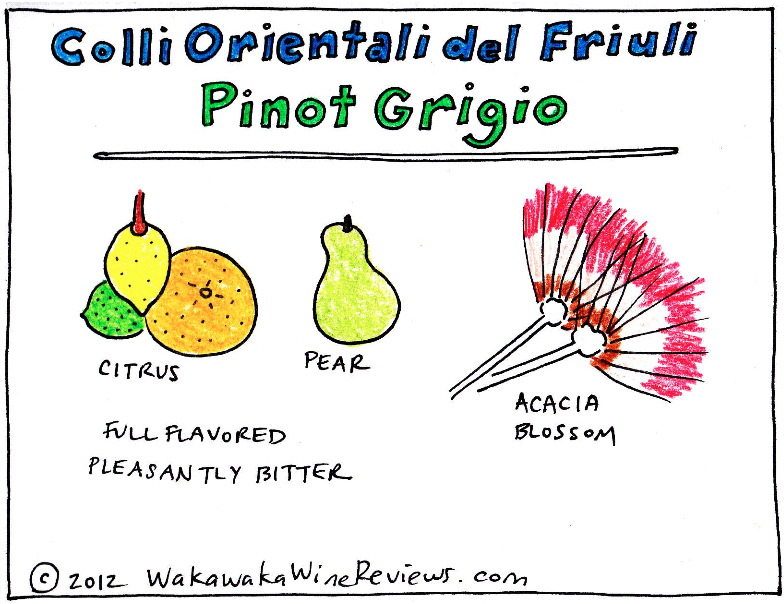
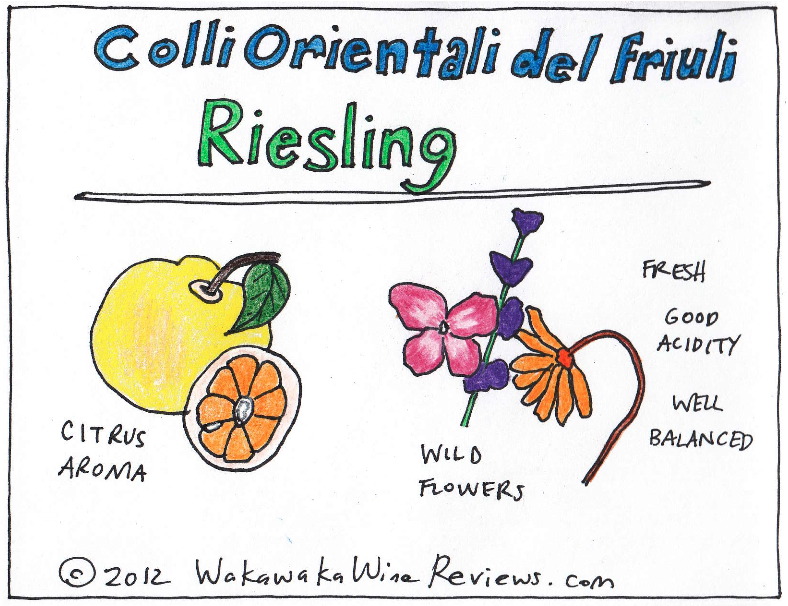

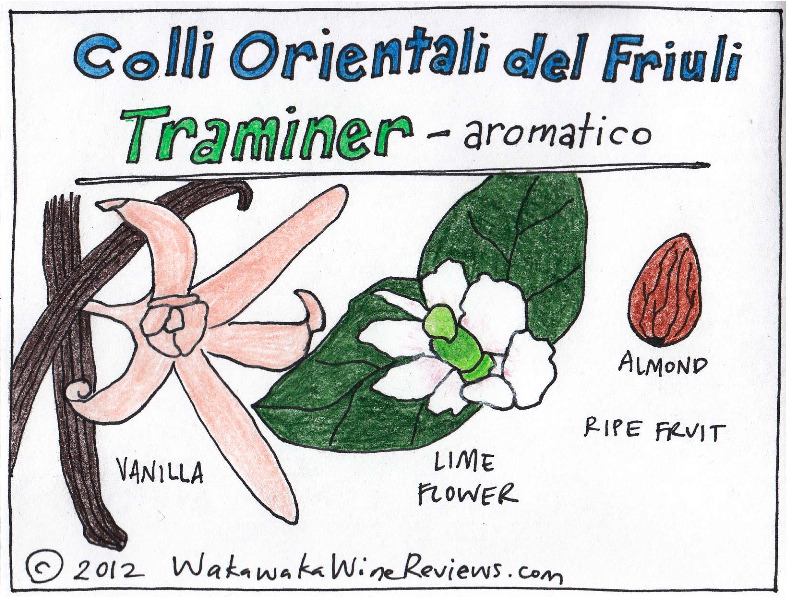

Veramente belle e oroginali le schede dei vini che hai pubblicato. E’ emozionante vedere la tua terra pubblicata oltre oceano.
Ciao Sandro Vizzutti
Well written and well illustrated.
Enjoyed going through it.